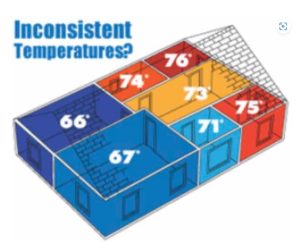Top 5 Reasons Temperatures are Fluctuating Throughout Rooms in Your Home

There is nothing more frustrating than having uneven temperatures in various rooms around your house. The temperature in one room can be fine (most likely where your thermostat is located!) and the other rooms can be freezing or too hot. This can be a real problem both in the summer and winter. And you might feel that your AC or furnace is running just fine, so what is the problem?
We hear you! Temperature imbalances can be caused by a myriad of factors – usually there are a number of factors at play.

Here are the top 5 main reasons temperature imbalances might be happening in your home. Some fixes or adjustments can be done by yourself – yes, we have all heard of duct tape! But, in most cases, it is best to consult with a professional to get an accurate assessment of your particular home. Pinpointing the problem is the first step in finding the right solution for your home.
A single thermostat located on your main floor will likely create temperature imbalances on the higher second floor or in the basement. Your furnace or AC will run to match the temperature set on the thermostat in that room – not on the other floors.
And since hot air rises – heat will naturally rise from the lower floor to the higher floor. This will cause the lower floors to be a bit cooler than the upper floor in a home. So, rooms far away from the thermostat will not get the full benefit of your furnace or AC.

Sometimes there are leaks in your ductwork. Some people can loose up to 30% of the heat or cool air that is coming from your furnace blower through these leaks. If you have large leaks from loose joints, huge amounts of air can escape and the rooms at the end of the ductwork line will not receive any heat. This means your equipment is running overtime and your energy bills are much higher than they need to be.
Obviously, rooms nearest your furnace or your AC source will naturally get the majority of the conditioned air. Those rooms that are located further away or at the ends of the ductwork receive far less airflow – this problem is compounded if there are leaks in the ductwork along the way. Even though your vents are open, the air will not be properly heated or cooled.
Similarly, if your ductwork or HVAC is the wrong size for your home, you won’t get the airflow you need. Not only will this impact the balance of heating and cooling in your home, but it can possibly cause long term damage to your system. In the cold months, improper airflow can cause your system’s evaporator to overheat and fail prematurely. In the warm months the opposite problem occurs: your system can cause coils to freeze up.
Your home will not properly retain heat or cool air, if your have poor insulation. Poorly insulated rooms often suffer from air leakage and infiltration.
Which can occur around Gaps, cracks, and inadequate sealing around windows, doors, electrical outlet.
You’re going to end up wasting energy and spending more to condition the entire house. You will end up running your system longer than necessary to heat and cool your house, which can be expensive in the long run.
A bigger furnace isn’t always better. If you have an HVAC system that is too large, it may cycle on and off – and sometimes shut off too quickly—not allowing the cool or warm air to reach all levels and all rooms. And, if the unit is too small it may not be able to keep up and warm and cool the entire home. A1 is happy to consult with you on this – we would only recommend the proper-sized HVAC system based on your duct work and the square footage of your home.
We all know that a room that faces the sun for the majority of the day will naturally be warmer than rooms facing shade or a dark area. The size and number of windows in those rooms can have an effect on the temperature as well. If the windows are not well sealed, this can allow warm air to seep slowly out during the winter.

What can I do about some of these issues?
Find and patch leaky ductwork. Yes, you can do minor patch work on your ducts yourself, but it is always a better bet to hire a professional who can come in and do a pressure check on your ducts. You might not be able to see minor and major clogs or leaks on your own so best to have it looked at by professionals who use specialized equipment to identify leaks accurately. And remember that “clean” ducts conduct air more efficiently and add to improved air quality in your home.
 Increase beneficial airflow within your home. If you’re dealing with unbalanced heating and cooling, consider turning on the furnace fan so it runs constantly. If your furnace fan is set to AUTO, it only runs when the furnace or AC is going.
Increase beneficial airflow within your home. If you’re dealing with unbalanced heating and cooling, consider turning on the furnace fan so it runs constantly. If your furnace fan is set to AUTO, it only runs when the furnace or AC is going.
Set the fan to ON – and you will find the air will move around your house on a regular basis which improves the comfort level for you and your family.
Manual fans serve a purpose in both the winter and summer. In the summer, we can all use plug-in fans to circulate the cooler air that pools on lower levels. But don’t forger that in the winter, you can also use these same fans to push the warm air down to areas of your house where you need it.
Keep all air vents open. To ensure proper cooling throughout the house, keeping all air vents open and unobstructed is important. However, closing the odd basement vent during the summer is practical. Additionally, closed air vents can lead to increased pressure in the ducts, which can put additional strain on the air conditioning/furnace system and reduce its efficiency.
Always change out your furnace air filters on a timely basis. If the air filters are dirty or clogged, they can restrict the flow of air, reduce the system’s efficiency, and reduce cool and conditioned air that can reach each room.
Add a ductless heat pump for more effective zoned heating or cooling. You can add a heat pump (delivers hot and cold air) to rooms that are unnaturally chilly or too hot in the summer. Heat pumps have come a long way and are very energy efficient. A heat pump can lead to overall reduced energy consumption for your home – which can result in lower utility bills. All good things! Click here for more info on ductless heat pumps
Upgrade or change out your HVAC system. If your HVAC or ductwork is improperly sized for your home, you may need to replace your existing furnace or AC altogether. This is your costliest option, but the right equipment can give you better control over the temperature on different floors. We recommend having your system inspected by an HVAC professional to determine if this is the way to go.